Thursday 12 August 2021
Norfolk
Marcus Nash
I joined up with Marcus and 5 others for the latest Wader Spectacular at Snettisham. It meant an early, 02.30, start to meet the group at 06.30 at Fakenham.
Marcus' report is copied below in full.
12 August 2021 Spectacular
A Wader Spectacular today, we spent the morning up on the Wash watching the flocks of swirling waders followed by a couple of hours at Titchwell in the afternoon. It was a bright day with some nice sunny spells, and a brisk SSW wind.
It was an early start to get up to the Wash in good time ahead of high tide this morning. When we arrived on the seawall, the tide was already coming in, but there was still lots of mud exposed. There were already some large groups of waders gathered together, Oystercatchers, Knot and Bar-tailed Godwits strewn out over the mud. We looked at some of the closer godwits and Knot in the scope, many still in rusty breeding plumage.
Occasionally, as the water rose to lap up around them, the Knot would fly up and swirl round, landing higher up away from the rising tide. A small group of Golden Plover were surprisingly well camouflaged against the brown mud. They didn’t linger, and while we were watching them took off calling plaintively and disappeared off inland.

There were lots of smaller waders around the little pools below us. Mainly Ringed Plover, plus several Dunlin and Turnstone, including some smart birds still with their chestnut striped upperparts, and a few pallid Sanderling. A single silvery-grey and white Spotted Redshank, already in non-breeding plumage, was feeding busily in one of the pools.
A Yellow Wagtail called as it flew up from the beach below us. There were small numbers of Swallows and Sand Martins on the move today, heading south along the coast, the first step on the long journey down to Africa for the winter. A reminder that summer is nearly over.
There were lots of terns on the mud up towards the sailing club too. Mainly Common Terns but with a few Sandwich Terns and Little Terns in with them. We had already had a good look through them before the tide quickly started to cover the mud along the shore and they flew further up ahead of the rapidly incoming water. The waders which had been gathering there started to peel off in groups and fly past us too.
Pretty quickly, the mud in front of us was completely covered, so we continued on down towards the hides. We stopped again in front of Rotary Hide to watch the next instalment. The highlight here was the ‘March of the Oystercatchers‘. While the other waders tend to wait for the rising tide to meet them before flying up and landing again higher up, the Oystercatchers will walk away from the water. The whole flock, hundreds of them, appears to be one amorphous mass flowing up the mud away from the tide. Great to watch!

We continued on down towards the end, opposite Shore Hide. As we passed some of the other locals, we were told that the White-rumped Sandpiper had put in a brief appearance on the far side of the channel before flying back into the hordes of waders. Things have a habit of moving very quickly on the rising tide, so we figured we would probably stand a better chance of seeing it later, on the falling tide.
The waders were increasingly packed tightly into the last remaining corner of exposed mud. Yet more birds were flying in, lines of still black-bellied Grey Plovers over the water from higher up the Wash, large flocks of Knot over the saltmarsh from further out. A Common Sandpiper flew past and disappeared up the channel into the saltmarsh. A Greenshank dropped in briefly in the edge of the mud, before flying off calling. We picked up three Black Terns flying in together low over the water, before they disappeared into the melee. A juvenile Mediterranean Gull flew past us close in. The birds were getting increasingly squashed into the corner.
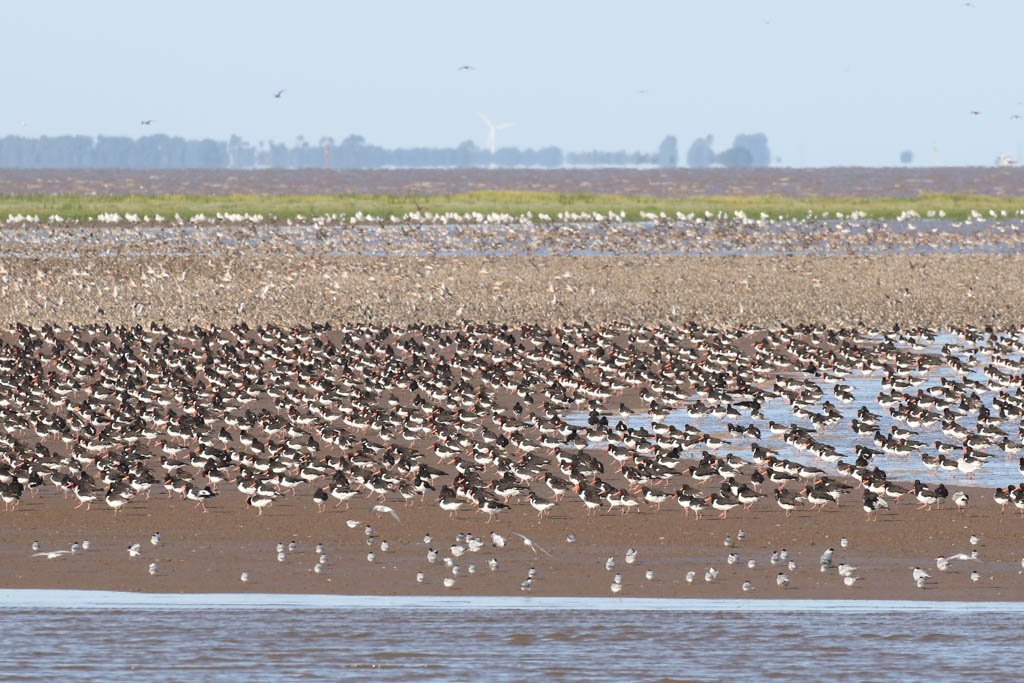
The tide looked like it would be just about high enough to cover all the mud today, but with the fresh SSW wind potentially holding it up, the tide went slack and the birds settled, just about fitting into the remaining corner. They were squeezed in very tight though and shuffling nervously and all it needed was something to set them off. A couple of Marsh Harriers were quartering over the saltmarsh beyond.
We stood in the sunshine and watched. Several times the birds erupted. Sometimes, it was a false alarm and after a bit of swirling they settled quickly back down. Other times, perhaps the Marsh Harriers got too close and they went up more purposefully. We were treated to some great displays, as they twisted and turned in unison, flashing alternately dark and bright white in the sunshine, making a varied catalogue of shapes in the sky. Wow!

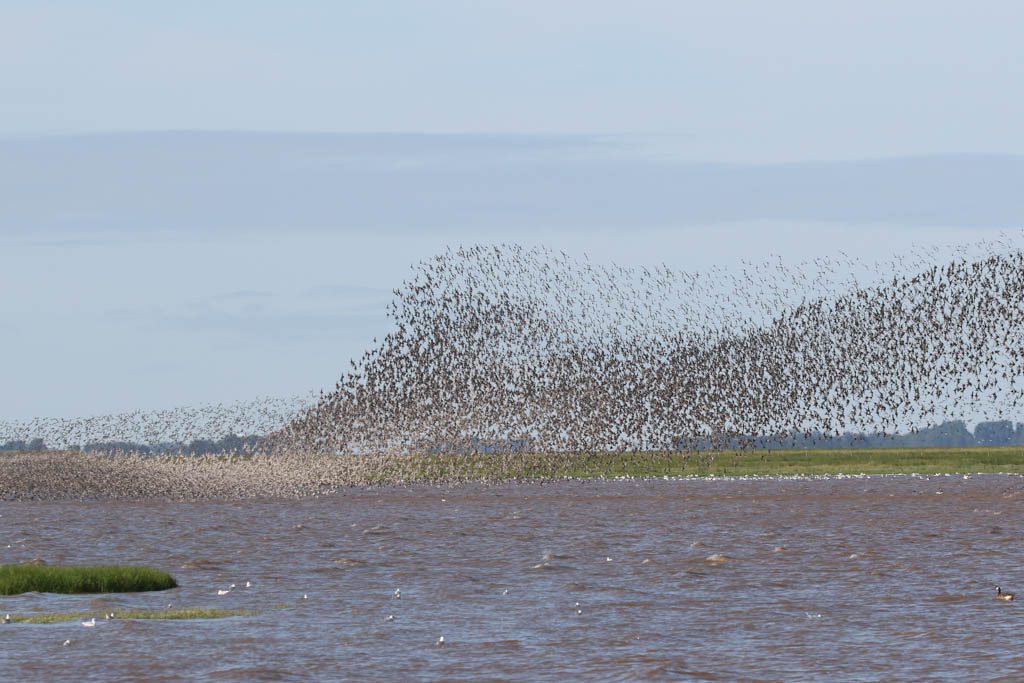

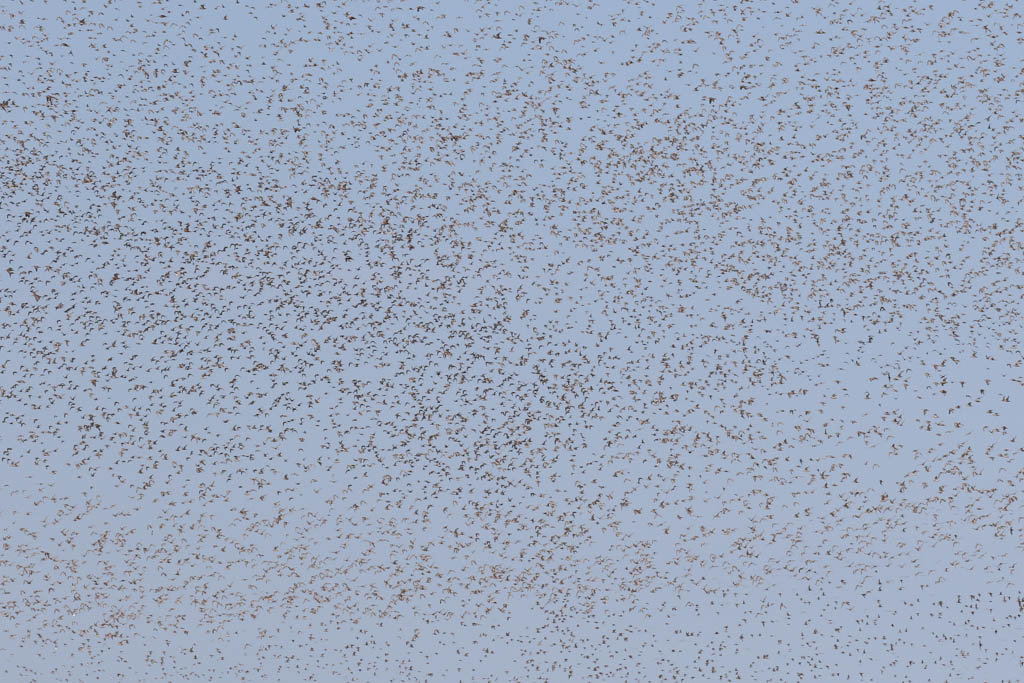
Each time they went up, some birds gave up and came in to roost in the pit. Several lines of Knot and Dunlin came in past us and dropped down into the pit behind. So when the waders out on the Wash seemed to settle down a little, we decided to have a quick look from the hides. We went into Shore Hide.
The islands weren’t full today, but there were still lots of Knot and Dunlin packed onto parts of some of them. We had just got the scope onto one group of them when someone already in the hide pointed out a Curlew Sandpiper hiding nearby. It was hard to find at first – asleep, head on, just one more bird with rusty orange underparts in a flock which was fairly packed with them (summer plumage Knot are orange below). But as the flock shifted and shuffled it came to the front where we could all get a look at it through the scope, and when it woke we could see its bill, longer and distinctly decurved (from whence it gets its name).

There were at least ten Spotted Redshanks on the pit too, roosting in their usual place on the rocks, in amongst the Cormorants today. The shingle bank on the far side was covered in Black-tailed Godwits, and there were more on one of the islands away to the north. We had a good scan round, but couldn’t see anything else unusual on here today, so we made our way back outside.
The tide had already started to go out and there was more mud exposed than there had been at its height. Some of the waders had already shifted and were no longer packed so tightly into the corner. Others flew up and landed out closer to the edge of the receding waters.
Scanning carefully through the lines of terns out on the mud, we found one of the Black Terns. Thankfully we had a good look at it before everything spooked and it disappeared. A dark Arctic Skua flew in down the Wash, along the edge of the water, occasionally breaking off to harry some of the terns. It had a go at some young Herring Gulls and then the tables were turned and the gulls chased it off in return.
When all the waders erupted, we scanned and picked up two Peregrines coming in quite high over the saltmarsh. We followed one of them as they chased after one of the flocks, causing it to twist and turn ahead of it. It was a juvenile, a young bird, inexperienced, and it didn’t seem to know how to pick a bird out of the vast flocks.
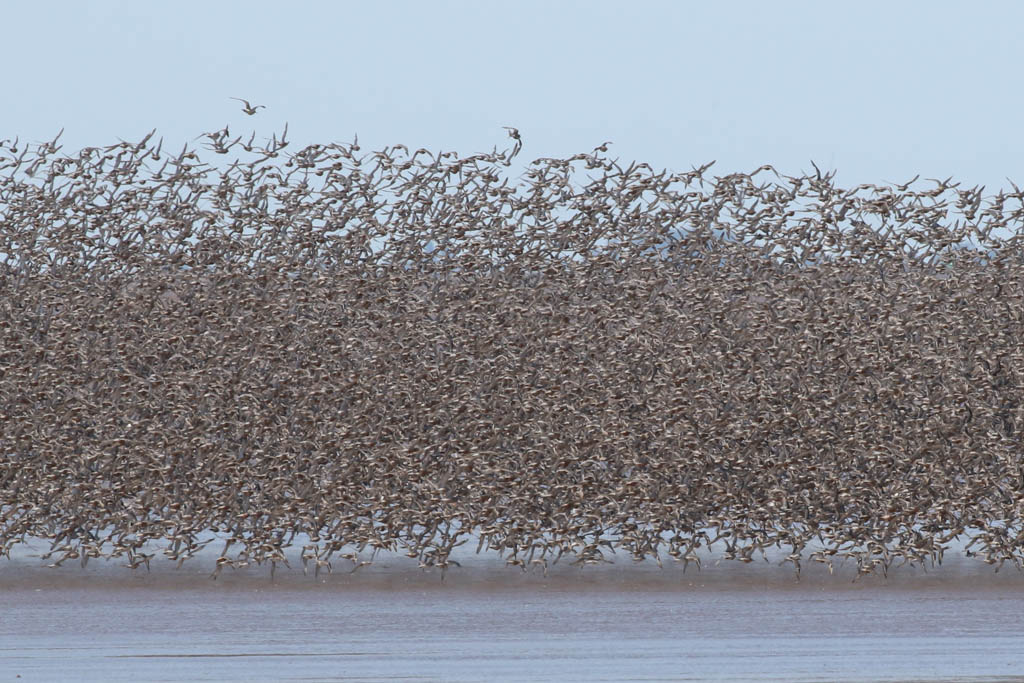


We had lost sight of the Peregrine we had been watching when an adult appeared low over the mud right in front of us, pursued by a Common Tern. It seemed to be struggling to gain any height as it had something large in its talons. Speaking to others later, who had been standing further up and seen it, it had apparently caught a Bar-tailed Godwit, a not inconsiderable prey item for a Peregrine. It evaded the tern and landed out on the now dry mud in the corner, where we watched it plucking its prey through the scopes.
The juvenile Peregrine then flew in off the Wash again from the north and over the pit, where it spent a couple of minutes stooping at the birds on the islands – causing mayhem and flushing everything – before disappearing off inland.

When everything settled down again, it was clear that most of the waders had moved further out now. We decided to start making our way back. The White-rumped Sandpiper had fed for some time off the seawall yesterday on the receding tide, so we hoped we might be able to find it again today. We were beaten to it, as we came across a small crowd watching it from the bank.
We got the scope on it. The White-rumped Sandpiper was feeding out on the mud amongst all the Dunlin, not easy to pick out but thankfully someone else had done all the hard work for us. We could see the White-rumped Sandpiper had a clean white belly, lacking the black patch or streaks of the Dunlin, and had a different shape, with longer wings. A single Little Stint nearby was noticeably smaller than even the Dunlin.

Back in the minibus, we made our way across to Titchwell for lunch and to use the facilities, cutting inland to avoid the traffic jam on the coast road. We managed to find a picnic table. A Common Buzzard drifting overhead and several House Martins over the sallows were additions to the day’s list.
There is a major – and very exciting for the future – works programme underway at Titchwell through late summer and autumn, aiming to completely renovate the Freshmarsh and reedbed. During August, there will be diggers out on the Freshmarsh to create new islands and divide it into three separate compartments, which will inevitably create some disturbance. We had very helpfully received updates from people during the week and we had a chat with the warden over lunch. We just wanted to have a quick walk out before we finished, so we decided to have a look.
As we got out of the shelter of the trees, it was rather breezy – the wind seemed to have picked up a little – but it was now warm too. We stopped by the reedbed, where a young Marsh Harrier was hanging in the air over the back. A Great White Egret appeared, flying round over the reeds before dropping down onto the reedbed pool. It was quickly flushed again by Grey Heron, which chased it for a while, the two very similar in size.

There were a few ducks on the reedbed pool, but it is not the best season for looking at wildfowl – the drakes are all in their drab eclipse plumage. We continued on to Island Hide.
We could see a couple of diggers on the Freshmarsh, over in front of Parrinder Hide. Thankfully, it didn’t seem to be putting the waders off, which were all over on the opposite side, closer to the reedbed. With low water levels to enable the works to take place, the shallows were packed with Avocets, Lapwings and Black-tailed Godwits. Several Ruff were making use of where the diggers had churned up the mud to look for food. In amongst the throng, we found a single Spotted Redshank and a juvenile Little Ringed Plover.
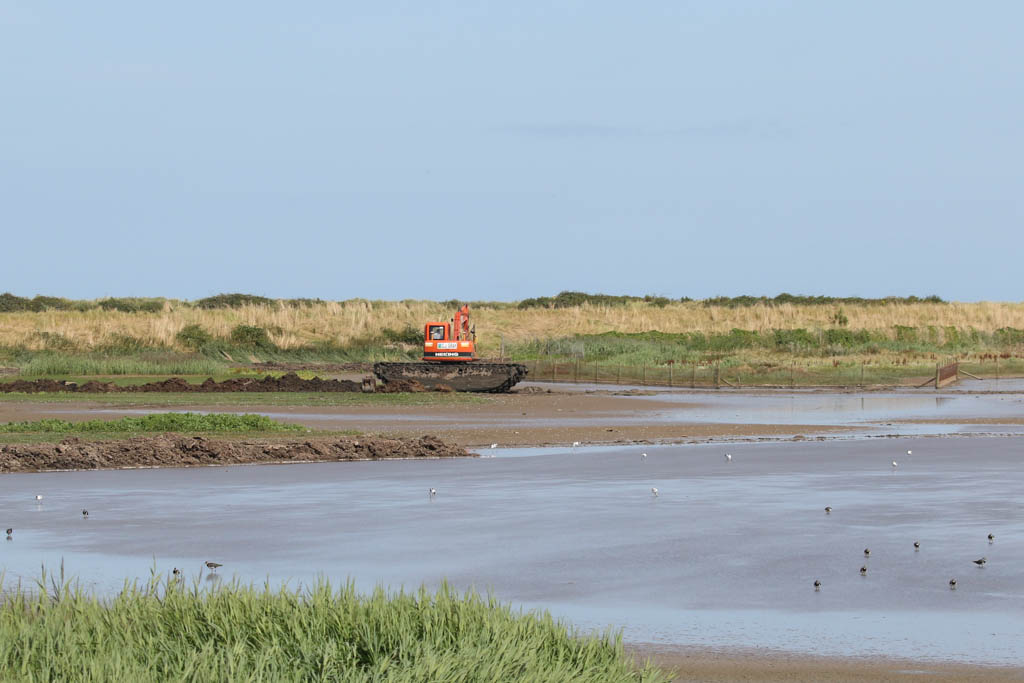
Scanning along the edge of the reeds, we came across a Water Rail bathing. When it had finished, it came out onto the edge of the mud to preen, where we had a great look at it through the scope. Then something spooked it and it ran straight back and disappeared into the reeds.

We were hoping to find a Bearded Tit here. It was a bit too breezy by the main path, but they do like to feed around the edge of the Freshmarsh at this time of year. At first, all we could find were one or two Reed Warblers. We had turned our attention back to the waders when one of the group noticed a juvenile Bearded Tit working its way along the base of the reeds opposite the hide.
We didn’t have a lot of time today, after our early start, but we decided to have a quick walk out to the beach before we finished. Volunteer Marsh was quiet but we did find five more Spotted Redshanks asleep on Tidal Pool as we passed. Out on the beach, we had a quick look at the sea where a few Sandwich Terns were flying back and forth offshore. The tide was out and there were more waders out on the mussel beds.
Unfortunately, it was already time for us to head back. We came off the beach just in time to see two Spoonbills fly over the path and head out over Thornham saltmarsh, their long necks and bills stretched out in front. We heard a couple of Whimbrel calling on the walk back, more birds on the move today, but they were distant and didn’t come in to the reserve.
The end to another Spectacular day.
No comments:
Post a Comment
Note: only a member of this blog may post a comment.